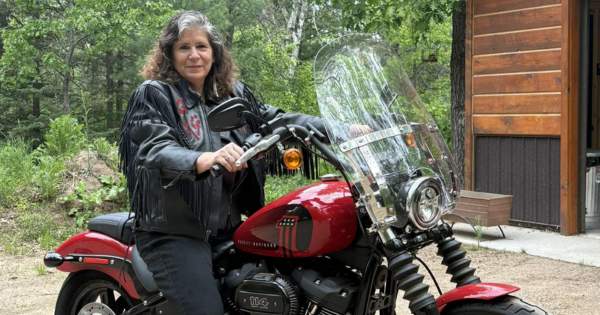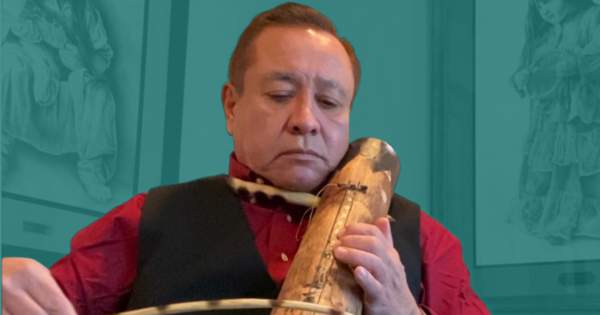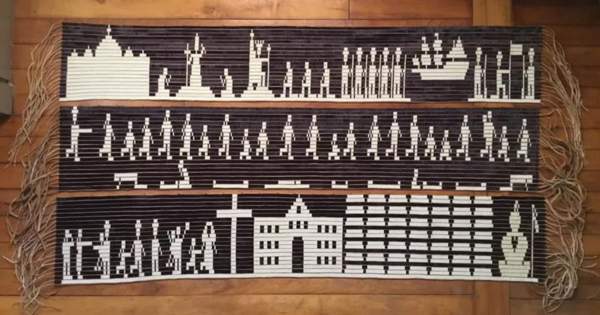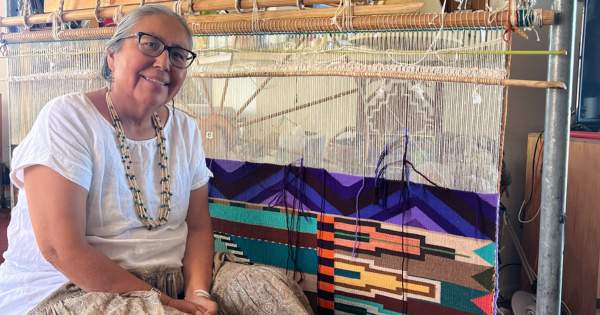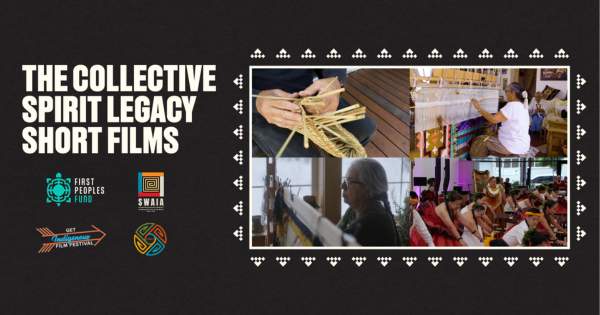
Immersed in Lakota Territory
By Sarah Elisabeth Sawyer (Choctaw Nation), Artist in Business Leadership Fellow 2015
A strong wind blew across the grasslands as we huddled together, sheltering between vehicles. It was a quiet moment for a group of 50, a time of silence as all gathered close and waited. We stood at the top of a hill near the Wounded Knee Cemetery and the site where a band of Lakota people were massacred in 1890.
We prepared for this time at the Lakota College Historical Center in Kyle where we viewed photos and heard the story of Wounded Knee. The time came to experience the place and feel the emotions.
First Peoples Fund President Lori Pourier (Oglala Lakota) introduced Tashina Banks Rama (Oglala Lakota / Ojibwe), daughter of Dennis Banks, to share a piece of the second Wounded Knee story when the American Indian Movement occupied the town in 1973. After tearful stories, Tashina went around to those gathered, offering tobacco for ceremony and was embraced with long hugs by the those in the group.
Led with a prayer song by Guss Yellow Hair (Oglala Lakota), who bore the Eagle Staff, the group fell in line to enter the cemetery and pray as we slowly walked around the chain link fence that marked and protected the mass grave. Circling to the front again, Guss opened up the time for anyone to sing or pray. Hawaiians in the group offered chants and wove the braided lauhala leaves they’d brought with them for this purpose they around the top of the fence. “We wanted to bring deep aloha,” said Vicky Holt Takamine (PA’I Foundation Executive Director).
American Indians used the hand drum for prayer songs or gave a warrior’s cry. African Americans offered brown sugar. Some people knelt on the earth and prayed for healing. Intercultural Leadership Institute (ILI) fellow Angie Durrell played “Closer to my God” on violin.
“It was so beautiful,” Lori Pourier said. “That’s never happened, for someone to play a violin there.”
Across the cultures, we felt the pain of the past and connection with that place.
This moving time at Wounded Knee came in the middle of the Intercultural Leadership Institute — Lakota Territory, hosted by First Peoples Fund (FPF). The journey had begun a few days before in the Black Hills, HeSapa, sacred ground for the Lakota People.
Ron Martinez Looking Elk (Isleta / Taos Pueblos), FPF trainer and board member, organized the opening circle. Carlton Turner, Alternate Roots Executive Director, officially passed ILI to Lori Pourier and FPF from the institute’s previous immersion experience in Jackson, Mississippi in March.
The circle continued around with fellows, partners, and guest introductions. People from Hawai’i and California, across to New York and Rhode Island and states in between came to South Dakota where they learned about Lakota people and their homelands.
The focus throughout was immersion in Lakota Territory, giving the 30 ILI fellows an opportunity to experience that place. One fellow commented that it was “a privilege to be in this space, that Lori trusts us to bring us here to learn about their history and culture.”
It wasn’t always an easy experience. Emotional, physical and mental drain on the group was brought up by some of the fellows. Leaders of the partner organizations that founded ILI adjusted the schedule and allowed for time to process the traumatic history and the pain of similarities woven through all cultures.
The group covered hard topics about the structure of ILI and how to address issues in the future. The partners welcomed input about the previous convening, and fellows voiced concerns and also their appreciation for the collaboration efforts to grow interculturally as leaders and embody the purpose of the institute. ILI aims to develop an innovative, arts-centered, bold demonstration of intercultural collaboration, learning, and leadership development.
“The work you do is rooted in your heart and your values,” Lori said. “Take these 18 months to build relationships.”
The fellows have made many connections through the institute so far. “I’m here to learn, and I’m enjoying learning from every one of you,” said ILI fellow and First Peoples Fund Artist in Business Leadership fellow Wesley May (Red Lake Band of Chippewa). “We interconnect and share goals. We learn the most from each other.”
That was a takeaway for everyone — the commonalities we have and the efforts to reclaim what was taken or lost. It’s complex work.
“We knew we wanted to help create a different paradigm of the way arts, culture and our communities are supported,” said Maria López De León (NALAC President and CEO). “With shared understanding, we have a greater voice. We’re asking you (ILI fellows) to come along with us and together, find those answers and develop that new paradigm. You’re a part of creating this.”
The fellows acknowledged the importance of building solid foundations on common goals. ILI nurtures community, an atmosphere of like minds coming together with their different perspectives yet same thoughts.
“All these cultural experiences and these shared celebrations,” ILI fellow Jonathan Clark said, “It’s beautiful that humanity crosses all those different things.”
““All these cultural experiences and these shared celebrations. It’s beautiful that humanity crosses all those different things.”
— ILI fellow Jonathan Clark
“Most of all I see harmony,” Cassius Spears (Narragansett/Niantic) said. “What we’re doing is important, and I’m proud to be a part of it.”
Closing the Lakota Territory ILI Convening
On the final day, there was an opportunity for everyone’s voice to be heard in the closing circle when facilitator Tufara Waller Muhammad asked everyone to share what was resonating with them in that moment after all they’d experienced during five days of immersion in Lakota Territory. Responses ranged from sincere gratitude to Lori and First Peoples Fund for hosting the journey, to the emotional bonding and support for one another among the fellows.
Throughout ILI there were moments of honoring, gifts given to speakers and leaders after sessions. After the final sharing, Lori gifted parfleche boxes made by FPF fellow Mike Marshall (Sicangu Lakota) and filled with sage bundles tucked inside by her daughter.
The convening concluded with intercultural leadership at work. Lori asked Angie Durrell to close out the Lakota Territory convening with a tune on her violin. ILI fellow Adam Horowitz planned to stay two extra days and shoot a video with Bryan Parker, FPF Rolling Rez program coordinator, about the importance of acknowledging place.
Even the experience of developing this institute, of cultivating spaces, has developed pedagogy through the process of defining intercultural leadership.
“I think everything I’ve experienced through ILI is intercultural,” one of the fellows said. “Being able to sit with a living, breathing person, listening to their stories about a past that has happened to all of us. I relate to that. The whole thing has been a wonderful, intercultural experience.”
There is much more to the Lakota Territory story. But the ILI fellows were able to leave with a sense of belonging in the territory and with the people who call it home.
We are looking ahead to the next cohort of Intercultural Leadership Institute fellows. Watch for the upcoming application opening.

